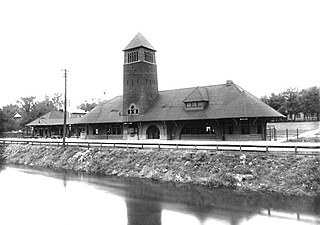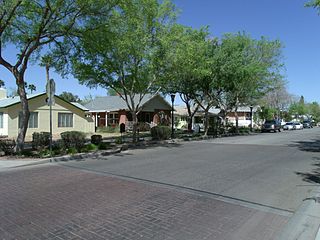
Fulton is the largest city in and the county seat of Callaway County, Missouri, United States. Located about 22 miles (35 km) northeast of Jefferson City and the Missouri River and 20 miles (32 km) east of Columbia, the city is part of the Jefferson City, Missouri, Metropolitan Statistical Area. The population was 12,600 at the 2020 census. The city is home to two universities, Westminster College and William Woods University; the Missouri School for the Deaf; the Fulton State Hospital; and the Fulton Reception and Diagnostic Center state prison. Missouri's only nuclear power plant, the Callaway Plant is located 13 miles southeast of Fulton.

The Margaret Mitchell House is a historic house museum located in Atlanta, Georgia. The structure was the home of author Margaret Mitchell in the early 20th century. It is located in Midtown, at 979 Crescent Avenue. Constructed by Cornelius J. Sheehan as a single-family residence in a then-fashionable section of residential Peachtree Street, the building's original address was 806 Peachtree Street. The house was known as the Crescent Apartments when Mitchell and her husband lived in Apt. 1 on the ground floor from 1925 to 1932. While living there, Mitchell wrote the bulk of her Pulitzer Prize-winning 1936 novel, Gone with the Wind.

Westminster College is a private college in Fulton, Missouri. It was established in 1851 as Fulton College. America's National Churchill Museum is a national historic site located on campus. The school enrolled 609 students in 2020.

College Hill is a neighborhood in the west central section of the United States city of Greensboro, North Carolina. College Hill was Greensboro's first neighborhood.
Winnona Park is a historic area in the southeast corner of the Atlanta, Georgia suburb of Decatur. It is listed as a historic district on the National Register of Historic Places, but it is not one of the City of Decatur's locally designated historic districts.

The East Jefferson Avenue Residential District in Detroit, Michigan, includes the Thematic Resource (TR) in the multiple property submission to the National Register of Historic Places which was approved on October 9, 1985. The structures are single-family and multiple-unit residential buildings with construction dates spanning nearly a century, from 1835 to 1931. The area is located on the lower east side of the city.

The Brandon-Bell-Collier House is a house in Fulton, Callaway County, Missouri, in the state of Missouri in the central United States. It was built in stages between about 1862 and 1917. From 1900 to 1902, it was owned by Fulton architect Morris Frederick Bell, who undertook a major remodelling, expanding the house to two stories and incorporating elements of the Queen Anne and Colonial Revival architectural styles.

Rogers and MacFarlane was an architectural firm based in Detroit, Michigan, founded in 1885 by James S. Rogers and Walter MacFarlane. The firm produced commissions in Detroit and southern Michigan from 1885 until 1912.
Morris Frederick Bell was an American architect known primarily for his institutional buildings but also for his domestic and commercial structures. His best known work is the David R. Francis Quadrangle the historic center of the University of Missouri including Jesse Hall. He also designed state correctional schools in Boonville, Chillicothe, and Tipton; and state mental hospitals in Fulton, Higginsville, and Nevada. Bell, a democrat, was also active in civic life, especially Masonic organizations. He trained and employed William Lincoln Garver as an assistant. Garver would later go on to have a stand-alone career.

The Catlin Court Historic District, established in 1914, is significant for its historic association with an important period in the development of the city of Glendale, Arizona, United States.

Rugby Road–University Corner Historic District is a national historic district located at Charlottesville, Virginia. The district encompasses 173 contributing buildings in the city of Charlottesville. It includes a variety of commercial, residential, and institutional structures mirroring the University of Virginia's development between the 1890s and the Great Depression. It includes properties on Carr's Hill. Notable buildings include the Chancellor Building (1920), the Minor Court Building, Mincer's Shop Building 1920s), the Stevens-Shepherd Building, Buckingham Palace, St. Paul's Episcopal Church (1926–27), Madison Hall (1905), fraternity houses dating from 1902 to 1928, Fayerweather Hall (1893), the Bayly Museum (1934), Faculty Apartments building, Watts-Hillel House (1913-1914), and Hotopp-Watson House (1900). Also located in the district are the separately listed Anderson Brothers Building, Preston Court Apartments, and Wynhurst.

North Washington Street Historic District is a national historic district located in the city of Bloomington of Monroe County, Indiana. The district encompasses 35 contributing buildings and 6 contributing structures in a predominantly residential section of Bloomington. It developed between roughly 1870 and 1929, and includes notable examples of Queen Anne, Classical Revival, and Bungalow/American Craftsman style architecture. Located in the district is the separately listed Morgan House. Other notable buildings include the Showers-Graham House, Showers-Myers House, Teter House, and Washington Terrace Apartments (1929).

Shortridge–Meridian Street Apartments Historic District is a national historic district located at Indianapolis, Indiana. The district encompasses 136 contributing buildings in a predominantly residential section of Indianapolis. It was developed between about 1900 and 1951, and includes representative examples of Colonial Revival, Classical Revival, Late Gothic Revival, Mission Revival, Renaissance Revival, Bungalow / American Craftsman, and Art Deco style architecture. Located in the district is the separately listed Shortridge High School. Other notable buildings include the Vernon Court Apartments (1928), Fronenac Apartments (1951), Biltmore Apartments (1927), Meridian Apartments (1929), New Yorker Apartments (1917), Howland Manor (1929), Powell-Evans House (1911), Harms House (1906), Dorchester Apartments (1921), and Martin Manor Apartments (1916).

Hall Street Historic District is a national historic district located at St. Joseph, Missouri. The district encompasses 43 contributing buildings in a predominantly residential section of St. Joseph. It developed between about 1870 and 1920, and includes representative examples of Italianate and Late Victorian style architecture. Notable buildings include the Karl Schatz House, Rolanda Court Apartments, Chase-McClain House (1870s), John Forest Martie House, Oak Ridge Apartments (1890), James H. Robinson - William W. Wheeler House (1883), Cummings Ogden House (1885), Bill Osgood House (1890), and Missouri Methodist Hospital - Huggins House (1908).

The Main Street–College Street Historic District encompasses a historically fashionable residential area of Burlington, Vermont. Principally located along Main and College Streets between South Winooski and South Williams Streets, the area was one of the city's most exclusive residential areas from the early 19th century to the early 20th century, and includes a diversity of high quality architecture from that period. It was listed on the National Register of Historic Places in 1988.

Capitol Avenue Historic District is a national historic district located at Jefferson City, Cole County, Missouri. It encompasses 107 contributing buildings in a predominantly residential section of Jefferson City. The district developed between about 1870 and 1947, and includes representative examples of Classical Revival, Late Victorian, Bungalow / American Craftsman, and Art Deco style architecture. Located in the district are the separately listed Lester S. and Missouri "Zue" Gordon Parker House, Jefferson Female Seminary, Missouri State Penitentiary Warden's House, and Ivy Terrace. Other notable buildings include the Parsons House (1830), former Missouri Baptist Building (1947), Grace Episcopal Church (1898), Elizabeth Alien Ewing House (1873), James A. Houchin House, J. Henry Asel, Sr. and Hilda Asel House (1898), Dix Apartments (1915), W.C. Young House, Bella Vista Apartments (1928), and Prince Edward Apartments (1930).
Historic District E is a national historic district located at Boonville, Cooper County, Missouri. It encompasses 88 contributing buildings in a predominantly residential section of Boonville. The district includes representative examples of Late Victorian style architecture. Notable buildings include the Dyer Residence (1870), Burns Residence, Rennison Residence (1890s), Lauer Residence (1830-1833), Robinson Residence (1905), Bell Residence (1886), Schuster Residence (1833), Kempf Residence (1890s), Cooper County Court Property, Morgan Street Baptist Church (1884), Waible Residence (1833-1848), and United Church of Christ.
Commercial Community Historic District is a national historic district located at Lexington, Lafayette County, Missouri. The district encompasses 106 contributing buildings and 1 contributing structure in the central business district and surrounding residential area of Lexington. It developed between about 1830 and 1930, and includes representative examples of Late Victorian and Gothic Revival style architecture. Located in the district is the separately listed Lafayette County Courthouse. Other notable buildings include the Lexington Racquetball Club, Missouri Public Service Storage Building, Franklin Diner, Wright House, Goehner's Marbleworks, First Presbyterian Church, Municipal Auditorium (1930), Leiter Apartments, Lafayette County Sheriff's Office and Jail (1939), Morrison Wentworth Bank Building, and Winkler Theatre.

Midtown Neighborhood Historic District is a national historic district located at St. Charles, St. Charles County, Missouri. The district encompasses 527 contributing buildings, 7 contributing sites, and 5 contributing objects in a predominantly residential section of St. Charles. It developed between about 1838 and 1959, and includes representative examples of Federal, Greek Revival, Gothic Revival, Italianate, Queen Anne, Romanesque Revival, Folk Victorian, Colonial Revival, Classical Revival, Tudor Revival, and Bungalow / American Craftsman style architecture. Located in the district are the separately listed African Church and Oliver L. and Catherine Link House. Other notable buildings include the St. Charles County Courthouse, Benton School (1896), St. John's A.M.E. Church (1872), Immanuel Lutheran Church (1867), Jefferson Street Presbyterian Church, Fourth Street Market Grocery (1926-1927), West End Grocery and Meat Market, Dr. Ludwell Powell House (1838), Rogers-Ehrhard House, Waye Monument Company and Residence (1889), Meyer House, Kaemmerlen House, and Elsner House.



















